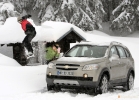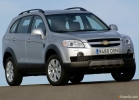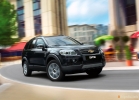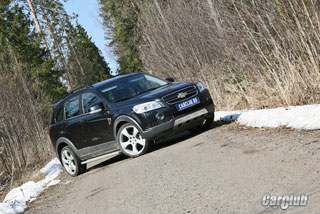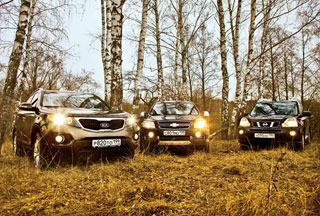CHEVROLET CAPTIVA test drive since 2006 SUV
Tatran horse
The news that General Motors would build a plant in Russia surprised many how again, again?! The memories of the previous attempts of the company to gain a foothold on Russian territory are still fresh.Only the joint production of Shevi-Niva became truly noticeable, but not a brilliant reputation of the car interferes with developing success to the enterprise. The venture with Korean cars under the Chevrolet brand looks good. Kapetiva marks a new stage of a quick Russian production of the latest model.
Think globally
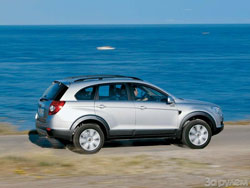 What should be modern SUV? The spacious, comfortable, safe, elegant, inexpensive by the way, General Motors considers this American abbreviation that we have not taken root. And the first car of this type of Chevrolet-Saberben Keriol appeared back in 1936. Now let's try to present all this at the present time, taking into account the incredible globalization, General Motors.
What should be modern SUV? The spacious, comfortable, safe, elegant, inexpensive by the way, General Motors considers this American abbreviation that we have not taken root. And the first car of this type of Chevrolet-Saberben Keriol appeared back in 1936. Now let's try to present all this at the present time, taking into account the incredible globalization, General Motors. Are we getting Korean design, Chinese refinement, European marketing and Russian assembly? Why not? The design of the Korean Bureau Ji-Em turned out to be better than Italian. Most of the running tests and fines in the early stages took place in the research center under Beijing. By the way, the entire program required 450 prototypes that ran more than five million kilometers. High -speed tests took only 12 weeks. However, with all due respect to Chinese comrades, they got only black work on the tests of the captives: they had to share with colleagues from Canada, Germany, Mexico, Great Britain and South Korea. There, Kaptiva passed the final tests, when 130 cars were transferred to employees of General Motors, who wound nearly a million kilometers.
Small but tall
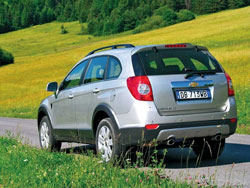 High tatra mountains are not comic (up to 2655 m), but very compact, they can be traveled by car in half a day. From the North, Polish side, Karol Voitil loved skiing, then an ordinary parish priest and the car history of the region was enriched by Hans Ledwinka, who developed unique tatra with the rear engine and air cooling, which went into the series back to the beetle Ferdinand Porsche.
High tatra mountains are not comic (up to 2655 m), but very compact, they can be traveled by car in half a day. From the North, Polish side, Karol Voitil loved skiing, then an ordinary parish priest and the car history of the region was enriched by Hans Ledwinka, who developed unique tatra with the rear engine and air cooling, which went into the series back to the beetle Ferdinand Porsche. The story of the Chevrolet-captivation is still weakly connected with the Slovak mountains, but their narrow and winding paths served as a good exam for a beginner. The captivation of the car is quite impressive: more than 4.6 m long, 1.7 tons of equipped mass, and motors are not less than 2.4 liters. However, the latest diesel engine (by the way, the first on compact chevrolet all -fruits) develops 150 hp. and 320 N.M with only a two -liter volume. All this thanks to the injection of fuel with the common highway and the adjustable nozzle of the turbine.
Gasoline engines, four-cylinder 142-horsepower and six-cylinder 225-horsepower, should radically change the idea of \u200b\u200bthe machine, because they differ by power by one and a half times. What captive to start acquaintance? Firstly, with all-wheel drive front-wheel drive to Russia will not go. Diesel too. There remains a choice between a four-cylinder with a mechanical KP and a 3.2-liter with a machine gun. The latter option is preferable.
Podgorny and Nagoric
 The interior of the captiva, as well as its appearance, most corresponds to the definition of neutral. Smooth, clean surfaces, well -adjusted panels, all fashionable features are formally observed, but there is nothing to catch on the eye. Looking at the front panel, you are perplexed that it is: Opel, Toyota, Hyundai? Oh yes, Chevrolet resembles a golden cross on the hub of the steering wheel. However, there are few complaints, for example, to the shape of leather seats: the pillow is short, the lateral stops of the backs are weak. But the steering column regulated only in the corner is a serious minus for the car entering the market in 2006.
The interior of the captiva, as well as its appearance, most corresponds to the definition of neutral. Smooth, clean surfaces, well -adjusted panels, all fashionable features are formally observed, but there is nothing to catch on the eye. Looking at the front panel, you are perplexed that it is: Opel, Toyota, Hyundai? Oh yes, Chevrolet resembles a golden cross on the hub of the steering wheel. However, there are few complaints, for example, to the shape of leather seats: the pillow is short, the lateral stops of the backs are weak. But the steering column regulated only in the corner is a serious minus for the car entering the market in 2006. The captivate with six and automatic transmission touches and accelerates very smoothly. The engine practically does not listen to 4000 rpm. Ahead is a simple but narrow mountain road. There are enough passing cars, and straight sections are short time to check the dynamics of the machine. It turns out that it turns out that 225 forces are desperately not enough! The delicate gearbox annoys a slow transition to a reduced gear. After 80 km/h, the captivist is not accelerated at all as you expect from a mild car with a powerful engine. From under the hood there is a bass buzzing, the speedometer shooter leisurely crawls in a circle, and the eyes jump from an approaching turn to a overtaking car: will I have time or not?
The need to enter the turn at increased speed becomes an obvious, but unpleasant duty steering, and the car itself is noticeably rolling and swaying.
But on a dirt road, a traction but blown by response on the pedal, coupled with a soft hydrotransformer, makes it possible to smoothly move on a rocky scree something almost impossible for a machine with mechanics.
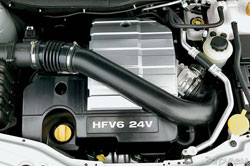 Surprisingly, the basic version with a 2.4 -liter engine meets better expectations. Of course, the dynamics are not at all missile, but in the third transmission this captivist is subjectively comparable to the version equipped with a machine gun and a large engine. Even the steering wheel has become more understandable, and the suspension of the assembled the same turns are given more confidently. Plus, also with combined upholstery. Leather sidewalls facilitate landing behind the wheel, and the tissue central part is much more comfortable in the heat and does not allow the back to fidget in corners.
Surprisingly, the basic version with a 2.4 -liter engine meets better expectations. Of course, the dynamics are not at all missile, but in the third transmission this captivist is subjectively comparable to the version equipped with a machine gun and a large engine. Even the steering wheel has become more understandable, and the suspension of the assembled the same turns are given more confidently. Plus, also with combined upholstery. Leather sidewalls facilitate landing behind the wheel, and the tissue central part is much more comfortable in the heat and does not allow the back to fidget in corners. Finally, diesel. The supply of the motor is not expected to us, but it’s interesting to try. A characteristic roar is noticeable only at idle or outside the car, it is almost inaudible in motion. The diesel wakes up quite late and smoothly increases the thrust, reaching a maximum of about 3000 rpm, and easily spins to a red mark of 4500 on a tachometer. With active driving, its appetite is not at all modest and rarely fits 10 l/100 km, but with smooth movement, completely different numbers of 7 liters per hundred are a great result for a large machine.
Are the prospects clear?
 The capivum is not endowed with bright character traits or outstanding running qualities. Chevrolet is considered General Motors as a brand with the most profitable price-quality attitude.
The capivum is not endowed with bright character traits or outstanding running qualities. Chevrolet is considered General Motors as a brand with the most profitable price-quality attitude. While the excitement reigns on the domestic market, at a reasonable price, the captive is provided. By the way, the name is similar to the English captive captive, captured. The car that wants to surrender to us does not look ambitious enough to capture leading places on the market. Perhaps this is the Trojan horse? More precisely, Tatransky. Or is it all just the fantasies of an open author?
A carrier body, a transverse engine, lack of a lowering gear in a handout, independent pendants in a circle. Perhaps the most noticeable difference from competitors is a seven -seater layout. So far, only Hyundai Santa Fe can offer it. On a good road Chevrolet-captiva is a front-wheel drive car. The rear wheels drive are carried out through a wet multi -disc clutch with electronic control and is disconnected when driving along a good road. Thanks to the electronics, the connection of all -wheel drive occurs quickly and almost imperceptibly, and the entire system is successfully combined with ABS and ESP, with which there are difficulties on machines with a rigidly connected all -wheel drive. By the way, the presence of all -wheel drive increases the mass of a car by only 75 kg.
Kaptive wants to please the widest audience, which appreciates primarily practicality.
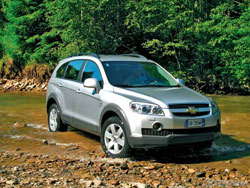
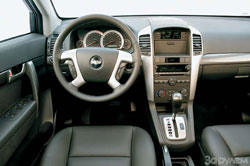



Anatoly Fomin
Source: The magazine "Driving"
Video test drives Chevrolet Captiva since 2006
Chevrolet Captiva Crash Video since 2006
CHEVROLET CAPTIVA test drives since 2006
Chevrolet Captiva Crash Test since 2006
Krassh Test: Detailed Information31%
Driver and passengers
17%
Pedestrians
36%
Children-passengers

